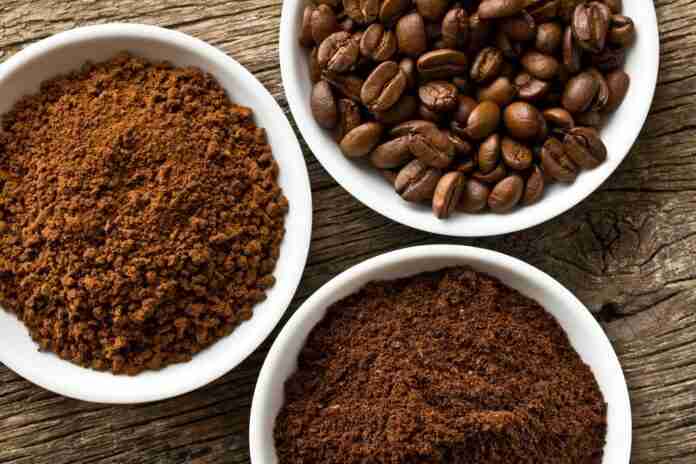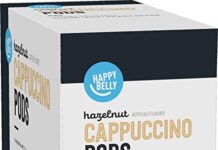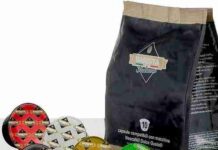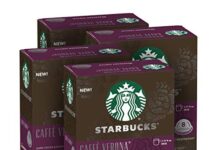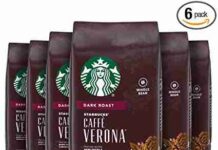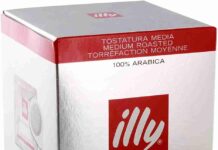Ever wonder about the different types of coffee grinds?
We will discuss the difference between whole bean, ground, and espresso roast coffees. Coffee can be purchased and enjoyed in various forms.
The most popular are whole beans, ground coffee, and espresso roasts.
Hopefully, this article will help you decide on the best coffee experience.
Everything you need to know about coffee grind size
Whole Coffee Beans
Freshness is practically guaranteed when you buy your coffee in whole-bean form.
The intact bean is like a wrapped gift, preserving the taste and aroma until the moment of grinding and brewing.
When shopping for a grinder, get a burr or mill type. They grind the beans to a uniform consistency, extracting the most flavor.
For those who rush about in the morning, the added step of grinding beans seems like a chore, but the taste of a freshly ground cup of coffee is such a reward that getting up a little earlier is worth it.
Ground Coffee
If your mornings are too hectic to add bean grinding to the daily routine, the next best thing is to buy freshly ground coffee from an artisan roaster or specialty coffee retailer.
Buy only as much as you will use in a week and store it in a sealed container, where it can’t be contaminated by sunlight and aromatic foods such as spices.
Ground coffee is available at any grocery store, but shop with care: because most consumers use an auto-drip coffee pot, most prepackaged coffee is ground at that setting, which is unsuitable for French Presses, espresso machines, and pour-over cones.
If you can’t find prepackaged grinds compatible with your brewing method, go to a specialty shop or order online.
Read Next – Jacobs Barista Editions Coffee Beans Dark Espresso Beans
Espresso Roast
Espresso roasts are incredibly dark and oily and traditionally used to make espresso.
Although roasters prefer Arabica, any bean can balance acidity, bitterness, and flavor.
Some say that although lower-grade robusta beans provide a superior crema, the golden foam caps a perfectly prepared espresso.
Be careful not to confuse espresso roasts with the beverage itself.
Espresso coffee is made from finely ground coffee with water forced through it at high pressure.
Technically, any roast can make espresso, although lighter ones won’t deliver the same taste experience.
To grind or not to bite? Blond roast or espresso?
It would help if you made these choices after considering your lifestyle, schedule, and taste preferences.
You are exploring different coffee grinds that will payoff to your perfect cup of coffee.
Read Next – Illy Classic Roast Coffee Beans Medium 250 g
If you’re like most coffee drinkers, you enjoy various coffee grinds to make your brew taste just the way you want it.
This article will discuss the different coffee grinds and why they matter.
By understanding the different types of coffee grinds, you can make better choices when selecting a coffee grinder for your home kitchen.
French Press
If you’re like most coffee drinkers, you probably grind your beans. But what kind of Grind should you use for your French press?
Three grinds can be used with a French press: flat, course, or acceptable. Each has its unique benefits. Here’s how they work:
Flat Grind: A flat grind is the simplest type and is best for standard drip machines. It’s not as delicate as a course or fine Grind, so that it won’t produce a high-quality cup of coffee.
Course Grind: A course grind is coarser than a flat and produces a more flavorful cup of coffee. It works best with French press pots that have a plunger mechanism.
Fine Grind: A fine grind is the most acceptable option and produces the highest quality cups of coffee. It’s also challenging to achieve, so you might only find it in specialty stores.
The type of ground coffee you use affects the flavor, brewing time, and temperature. Experiment to see which style works best for you.
illy, Ground Coffee Drip Grind (Medium Roast, Red Band), 8.8-Ounce Tins (Pack of 2)
Plunger-style coffee maker
When it comes to coffee grinds, there are a few things to keep in mind. First and foremost, the task should be coarse enough to release all of the flavor and aroma from the coffee beans.
Second, the Grind should be small enough to be evenly distributed in the coffee maker. Finally, choose a task that is compatible with your specific coffee maker.
Start with a coarser grind if you’re using a plunger-style coffee maker. This will help release all the flavor and aroma from the coffee beans.
For a standard drip machine, use a medium or fine grind. Check your machine’s instruction manual to determine what type of Grind is recommended for your particular model.
Finally, be sure to experiment with different types of grinds to find which ones work best for you.
Not all machines are compatible with every type of Grind, so it’s essential to try different ones until you find one that suits your preferences.
Automatic drip coffee maker
Coffee grinds are an essential part of any automatic drip coffee maker. What type of Grind you select is up to you, but there are a few things to remember. First, the finer the Grind, the more soluble the coffee will be in the water.
A finer grind will result in a weaker cup of coffee. Second, coarser grinds can be more intense and flavorful.
However, they can also contain more sediment, making your coffee gritty and unpleasant.
Finally, if you’re using an automatic brewer that uses filters, like most pod-based machines, you’ll want to choose a grind that’s fine enough to pass through the filter.
What are the four different types of coffee grounds?
Different types of coffee grinds are essential for several reasons. The first reason is that different grinds produce different flavors.
Second, different grinds improve the extraction of the coffee oils and flavor compounds from the coffee beans. Third, different grinds can affect the brewing process. Finally, different grinds can also affect how much coffee gets into your cup.
There are four main types of coffee grounds: coarseness, coarseness, finesse, and Turkish. Coarseness is the most common type and refers to the size of the grind particles. Coarse ground coffee will have larger particles than more OK ground coffee.
Finesse ground coffee is made up of smaller particles than coarser ground coffee. Turkish ground coffee is made up of medium-sized particles and is usually used in espresso drinks.
Knowing which type of ground coffee you’re using is important because it will affect the taste and amount of caffeine in your drink.
For example, coarse-ground coffee will make a more robust cup of java than acceptable grounds because more beans are exposed to water during brewing.
If you’re looking for a milder cup of java, go for a finer grind.
illy, Ground Coffee Drip Grind (Medium Roast, Red Band), 8.8-Ounce Tins (Pack of 2)
What kind of Grind is best for coffee?
If you’re like most coffee lovers, you love to experiment with different grinds and blends to find the perfect cup of joe for your taste.
But what is the best Grind for your particular coffee? And why does it matter?
There are a few different types of grinds, each with unique benefits.
Here’s a look at each type and why you might want to use it in your coffee brewing:
Boulder: This Grind is made from medium-to-coarse coffee beans that have been crushed into small pieces. It produces a robust, full-bodied flavor that withstands heavier creams and syrups. Because it’s so coarse, Boulder beans are less likely to have unwanted bitterness or acidity in your coffee.
French Press: Like Boulder beans, French press beans are ground fine but not as finely as Turkish or espresso beans. They produce a sweeter, more delicate flavor than other grinds and are well-suited for those who prefer soft drinks or cappuccinos.
Turkish: Also known as “espresso grind,” Turkish beans are finely ground and produce a robust and full-bodied flavor perfect for those who like their coffee with a little more kick. They’re also suitable for making espressos because they produce high-quality crema (a frothy milk foam).
Start with a French press or Turkish coffee if you’re unsure which grind to use. These grinds produce the most decadent flavor and most intense espresso.
If you want to experiment with other grinds, start with a lighter roast (like a Colombian), and increase the Grind if you need a more robust cup.
What is the most common coffee grind?
As coffee lovers, we know there are many different grinds, each with a unique flavor. So, what is the most common coffee grind?
According to a study published in the Journal of Agricultural and Food Chemistry, French press grinds are the most popular.
Why? Researchers say this Grind produces a strong flavor and aroma in coffee.
Read Next – How To: Get The Most Out Of Your Cuisinart Coffee Grinder
AmazonFresh Colombia Ground Coffee, Medium Roast, 32 Ounce
What does Arabica coffee mean?
Arabica beans are the most popular type of coffee beans. They are Grown in Brazil, Columbia, Ethiopia, and Indonesia.
Arabica beans are high-quality beans that produce a richer flavor than other types. They also tend to be more expensive.
When you buy coffee, the first thing you should decide is what type of coffee you want to brew. There are three main types of coffee beans: Arabica, Robusta, and Supra-Arabica.
Each has unique flavor and properties, making it an excellent choice for different coffee drinks. Here’s a breakdown of each type:
Arabica beans are the most popular and typically used for coffee brewed on the stove or in an electric coffee maker.
Arabica beans are grown in countries like Ethiopia, Kenya, and Yemen. They have a delicate flavor with fruity notes and a smooth finish. They’re best for light- to medium-bodied coffees.
Robusta beans are the second most popular type of bean and are used for more robust coffee drinks like espresso. These beans are grown in countries like Brazil, Colombia, and Indonesia. Robusta beans are best for solid coffees that need some depth of flavor. They have a fuller body with earthy flavors and a slightly bitter finish.
Supra-Arabica beans are the highest quality and are only used for premium coffee drinks like espressos. These beans are grown in Ethiopia, Yemen, and Costa Rica. Supra-Arabica beans have a deep, complex flavor with a smoky finish.
They’re best for robust coffees that need a lot of flavors.
Read Next – Coffee Grinder Reviews – High Quality Burr Grinders
What is the best Grind for drip coffee?
There are many different types of coffee grinds, and it can be a bit confusing to figure out which is best for your brew.
Today, we will explore the different types of grinds and why they matter.
French Press: The French press is perfect for a robust, full-bodied cup of coffee. The coarse Grind allows more surface area to contact water, resulting in a more flavorful cup.
Drip coffee: A medium grind is ideal for drip coffee. This will produce a smooth drink with just the right amount of flavor.
Italian Coffee: You’ll want to use a fine grind for Italian coffee. This will create a high-quality cup full of flavor and aroma.
Turkish Coffee: You’ll want to use a super-fine grind for Turkish coffee. This will make for a delicate cup full of flavor and aroma.
Read Next – Coffee Grinder Reviews – 3 Main Types
AmazonFresh Colombia Ground Coffee, Medium Roast, 32 Ounce
Types of Coffee Grinds
If you’re reading this, you likely already know that there are various types of coffee grinds and that each has its unique benefits.
In this article, we’ll look at the different coffee grinds and why they matter.
First and foremost, when it comes to brewing coffee, the type of Grind you use is critical. Different grinds will produce different results in terms of flavor and strength.
For example, French press grinds typically use paper filters for coffee. This Grind produces a more robust flavor than other types and a higher level of caffeine.
On the other hand, espresso grinds are typically used with machines that use finely ground beans. This Grind allows for a greater extraction level, resulting in a more acidic and less flavorful cup of coffee.
Beyond simply affecting the flavor and strength of your coffee, the type of Grind can also significantly impact how your cup looks.
When using coarse grinds, for example, water will be forced through the grounds more quickly than when using finer Grinds.
Sons of Amazon - 500g - The UK's Strongest Ground Coffee - STRONG AND FAIR - Dust Grind
Types of Coffee Grinds
There are a variety of different grinds that can be used to create coffee, and each has its unique properties.
This article will discuss the different types of coffee grinds and their benefits.
Fine Grind: Fine grinds are the most common type, typically containing between 26 and 30 percent ground coffee. They are ideal for making light and smooth coffee and are also suitable for automatic machines because they produce less heat than other grinds.
Medium Grind: Medium grinds contain between 31 and 37 percent ground coffee. They are ideal for making medium-bodied coffee with somebody. They are also suitable for use in automatic machines because they produce moderate amounts of heat.
Coarse Grind: Coarse grinds contain more than 37 percent ground coffee and are best used for making strong coffee. They are also suitable for automatic machines because they produce much heat.
Coffee is brewed by transferring hot water over grounds that have been finely ground.
Regular Grind: This is the most common type of Grind, and it works well for making drip or French press coffee. The grounds are acceptable, but okay, so they don’t clog up your machine. This is the best option if you want a consistent cup of coffee every time.
Types of coffee grind matter for several reasons. The type of coffee grind determines how much flavor the coffee will have, how finely ground the coffee is, and how evenly it will be brewed.
Different grinds also produce different heat levels, which can affect the coffee’s taste. Additionally, different grinds can be used to create different types of coffee drinks.
There are three primary coffee grinds: coarse, medium, and refined. Each has its advantages and disadvantages.
The most common coarse coffee grinds produce a strong flavor and heat. They are best for making espresso drinks because they create a thick, rich texture.
They are also suitable for French press coffee because they give it a more robust flavor.
Medium coffee grinds are somewhere in between coarse and fine. They produce a somewhat subtle flavor but less heat than coarse grinds and are suitable for making regular drip or drip-style coffee because they create a smooth drink with less bitterness.
They also work well in automatic machines because they don’t produce as much turbulence as finer grinds.
Read Next – A Comprehensive Guide To The Grind And Brew Coffee Maker
Conclusion
When it comes to coffee, you have many different options. Whether you’re looking for a strong cup of joe or something milder, the type of coffee grinds you use can make all the difference.
This article will discuss the different types of coffee grinds and why they matter. We’ll also give you tips on choosing the right one for your needs.
So, whether you’re new to coffee or want to improve your brewing skills, read on for advice on getting the most out of your joy fix!
Coffee Grind Sizes For Popular Brew Methods
Read Next – STARBUCKS Espresso Roast Dark Roast Whole Bean Coffee
Grind - Organic Coffee Capsules | Nespresso Compatible Coffee Pods | Coffee with Milk | Nutty & Chocolatey | Organic, Better Than Fairtrade & 100% Compostable - House Blend - 60 Pods
£25.50 in stock
Sons of Amazon - 500g - The UK's Strongest Ground Coffee - STRONG AND FAIR - Dust Grind
AmazonFresh Colombia Ground Coffee, Medium Roast, 32 Ounce
Starbucks Flavored Ground Coffee—Variety Pack—Naturally Flavored—3 bags (11 oz each)
Eight O'Clock Ground Coffee, The Original, 36 Ounce
illy, Ground Coffee Drip Grind (Medium Roast, Red Band), 8.8-Ounce Tins (Pack of 2)
Black Rifle Coffee CAF (Medium Roast, 2x Caffeine) Ground 12 Ounce Bag, Medium Roast Coffee, 100% Columbian Excelso Beans That Delivers Twice the Caffeine Punch of Average Coffee With a Rich, Smoky Flavor, Helps Support Veterans and First Responders
Allegro Coffee Mocha Java Ground Coffee, 12 oz
$10.74 in stock


